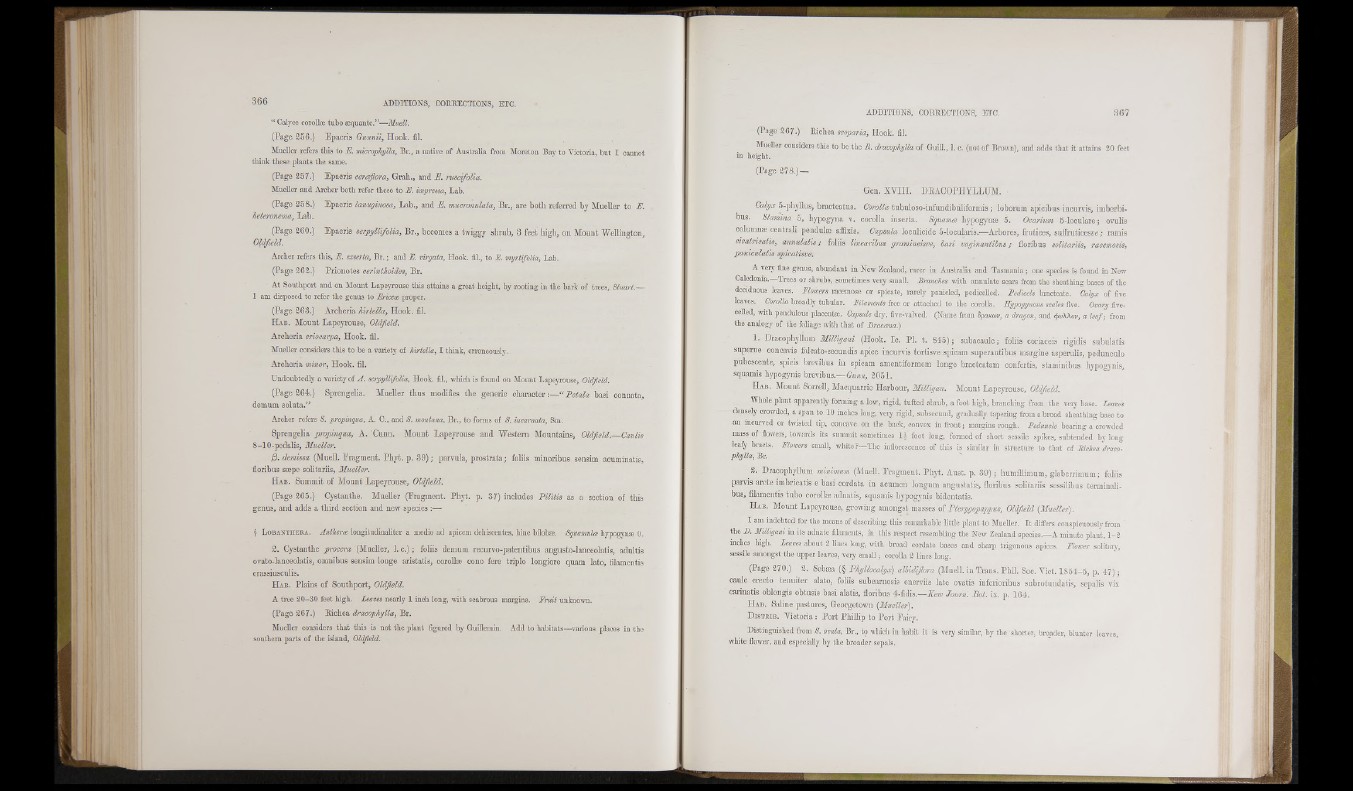
“ Calyce corolla? tubo æquante.”—Muell.
(Pago 256.) Epacris Gunnii, Hook. fil.
Mueller refers this to E. mici-ophylla, Br., a native of Australia from Slorcton Bay to Victoria, but I cannot
think these plants the same.
(Page 257.) Epacris ceroejiora, Grain, and E. ruscifoUa.
Mueller and ikicher both refer these to E. impressa, Lab.
(Page 258.) Epacris lanuginosa, Lab., and E. mucronulata, Br., arc both referred by Mueller to E.
heteronema, Lab.
(Page 260.) Epacris serpyllifolia, Br., becomes a twiggy shrub, 3 feet high, ou Mount Wellington,
Ai-cher refers tliis, E. exserta, Br. ; and E. virgata, Hook, fil., to E. myrtifolia, Lab.
(Page 262.) Prionotes cerinthoicles, Br.
At Southport and ou Mount LapejTOuse this attains a great height, by rooting in the bark of trees, Stuart.—
I am disposed to refer the genus to Ericees proper.
(Page 263.) Arcberia hirtella. Hook. fil.
H .1 B. Mount Lapeyrouse, Oldfield.
Archeria eriocarpa. Hook. fil.
Mueller considers this to be a variety of hirtella, I think, erroneously.
Archeria minor, Hook. fil.
Undoubtedly a variety of J . serpyllifolia, Hook, fil., wbich is found on Mount Lapejvonse, Oldfield.
(Page 264.) Sprengelia. MueUer thus modifies the generic character Pe/a/a basi connata,
demum soluta.”
Archer refers S. propinqua, A. C., and S. montana, Br., to forms of S. incarnata, Sm.
Sprengelia propìnqua, A. Cunn. Mount Lapeyrouse and Western îiountains, Oldfield.— Caulis
8-10-pedalis, Mueller.
E. demissa (Muell. Fragment. Phyt. p. 3 9 ); parvula, prostrata; foliis minoribus sensim acuminatis,
fioribus sæpe solitariis, Mueller.
H a b . Summit of Mount Lapeyrouse, Oldfield.
(Page 265.) Cystanthe. MueUer (Fragment. Phyt. p. 37) includes Pilitis as a section of this
genus, and adds a third section and new species :—
§ L obaNt u e e a . Anthera lo n g itu d in a lite r a medio ad ap icem d eh iscentes, h in c biloba?. Squamulæ h y p o g y næ 0.
2. Cystanthe procera (Mueller, 1. c.) ; foliis demum recurvo-patentibus angusto-lanceolatis, adultis
ovato-lanceolatis, omnibus sensim louge aristatis, coroUæ cono fere triplo longiore quam lato, filamentis
crassiusculis.
H a b . P l a in s o f S o u t h p o r t , Oldfield.
A tree 20-30 feet high. Leaves nearly 1 inch long, witli scabrous margins, Eruit unknown.
(Page 267.) Richea dracophylla, Br.
Mueller considers that this is not the plant figured by Guillemin. Add to habitats—various places in the
southern parts of the island, Oldfield.
ADDITIONS. CORRECTIONS, ETC. 8 67
(Page 267.) Richea scoparia, Hook. fil.
Mueller considers this to bo the Jl. imeojhjUa of Guill., 1. o. (not of Brown), and adds that it attains 20 feet
in height.
(Page 278.) —
Gen. X V III. DRACOPHYLLUM.
Cahjx 5-pliyllus, bracteatus. Corolla tubuloso-infundibuliformis ; loborum apicibus incurvis, imberbibus.
Stamina 5, liypogyiia v. corolla inserta. Squamæ hypogynæ 5. Ovarium 5-loculare; ovulis
columnæ centrali peudulæ affixis. Capsula loculicide 5-Iocularis.—Arbores, frútices, suffruticesw; ramis
cicatncatis, annulatis; foliis Ihiearihus gramineisve, basi vaginantibus; fioribus solitariis, racemosis,
A very fine genus, abundant iu New Zealand, rarer in Australia and Tasmania ; one species is found in New
Caledonia.—Trees or slmibs, sometimes very small. Branches with annulate scars from the sheathing bases of the
deciduous leaves. Flowers racemose or spicate, rarely panicled, pcdiceOed. Pedicels bracteate. Calyx of five
leaves. Corolla broadly tubular. Filaments free or attached to the corolla. Hypogynous scales five. Ovary five-
cehed, with pendulous placentæ. Capsule diy, five-valved. (Name from 3paKw, a dragon, and .^uAAov, a leaf; from
the analogy of the foliage with tliat of Dracæna.)
1. Dracophyllum Milligani (Hook. Ic. PI. t. 845); subacaule; foHis coriaceis rigidis subulatis
superne concavis falcato-secundis apice incurvis tortisve spicam superantibus margine asperulis, peduuculo
pubescente, spicis brevibus in spicam amentiformem longe bracteatam confertis, staminibus hypogynis,
squamis hypogynis brevibus.— Gk«k, 2051.
H a b . Mount Sorrell, Macquarrie Harbour, Milligan. Mount Lapeyrouse, Oldfield.
Whole plant appai-ently forming a low, rigid, tufted shmb, a foot high, branching from the veiy base. Leaves
densely crowded, a span to 10 inches long, very rigid, subsecuud, gradually tapering from a broad sheathing base to
an incurved or twisted tip, concave on tbe back, convex in front; margins, rough. Peduncle bearing a crowded
mass of flowers, towards its summit sometimes 14 foot long, formed of short sessile spikes, subtended by long
leafy bracts. Flowers small, wliite ?—The inflorescence of this is similar in structure to tliat of Bichea draco-
phylla, Br.
2. Dracophyllum mimimum (Muell. Fragment. Phyt. Aust. p. 3 9 ); humillimum, glaberrimum; foliis
parvis arete imbricatis e basi cordata in acumen longum angustatis, floribus solitariis sessilibus terminalibus,
filamentis tubo corollæ adnatis, squamis hypogynis bidentatis.
H a b . Mount Lapeyrouse, growing amongst masses of Pterygopappus, Oldfield [Mueller).
I am indebted for the means of describing this remarkable httle plant to Mueller. It differs conspicuously from
tbe B. MtlUgam in its adnate filaments, in this respect resembhng the New Zealand species.—A minute plaut, 1-2
inches high. Leaves about 2 lines long, with broad cordate bases and shaip trigonous apices. Flower solitarv,
sessile amongst the upper leaves, veiy small ; corolla 2 hnes long.
(Page 270.) 2. Sebæa (§ Phyllocalyx) allidifiora (MucU. in Trans. Phil. Soc. Viet. 1854-5, p. 4 7 ) ;
caule erecto tenuiter alato, foliis subcaniosis euerviis late ovatis inferioribus subrotundatis, sepalis vix
carinatis oblongis obtusis basi alatis, floribus 4-fidis.— Journ. Bot. ix. p. 164.
H a b . Saline pastures, Georgetown [Mueller).
D istuib. Victoria : Port Pbillip to Port Fairy.
Distingmshed from S. ovala, Br., to which in habit it is very similar, by the shorter, brojider, blunter leaves,
white flower, aud especially by the broader sepals.